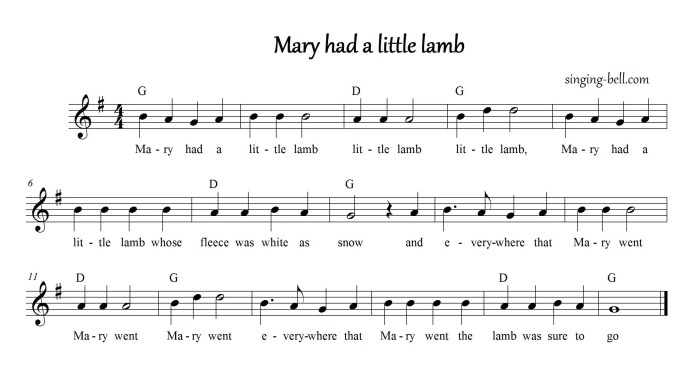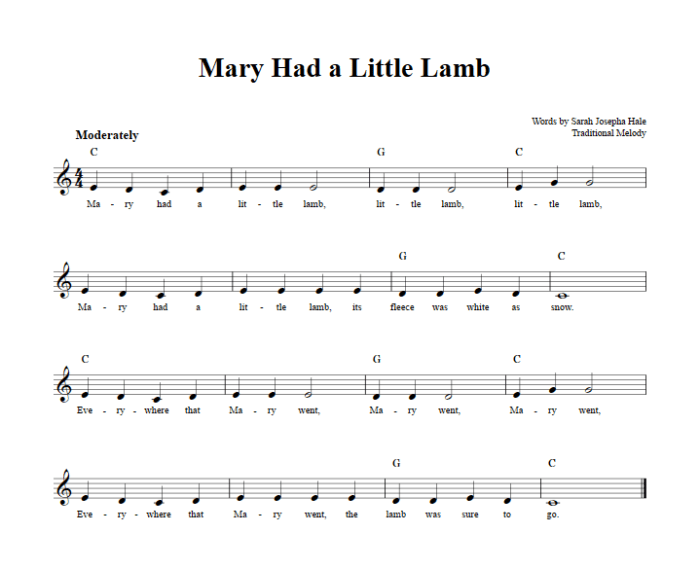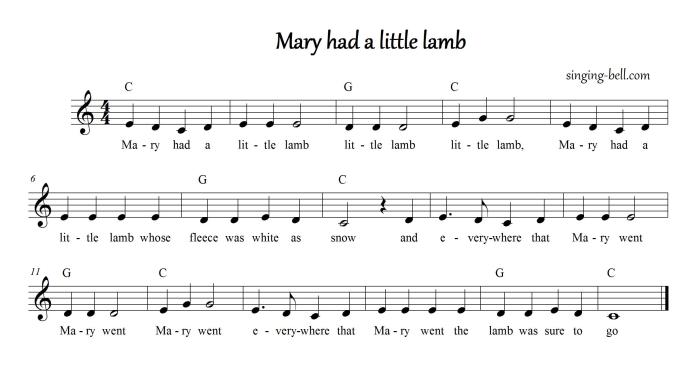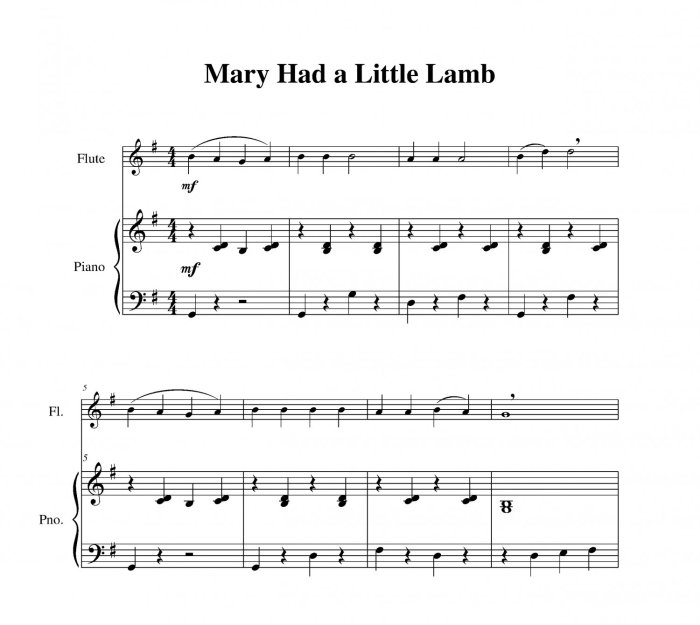The beloved children’s song “Mary Had a Little Lamb” has a rich history and a timeless appeal. Its sheet music, which has been used for generations to teach music fundamentals, provides a valuable resource for educators and learners alike. In this guide, we will explore the musical notation, historical origins, pedagogical use, variations, and cultural impact of the sheet music for “Mary Had a Little Lamb.”
We will also discuss its accessibility, design principles, and historical context, making it an indispensable tool for music education and appreciation.
The simple yet charming melody and lyrics of “Mary Had a Little Lamb” have made it a popular choice for beginner musicians. Its sheet music, which is typically written in the key of C major and 4/4 time signature, introduces basic musical concepts such as rhythm, pitch, and notation.
The clear and concise layout of the sheet music makes it easy for students to follow and understand, fostering their musical literacy and enjoyment.
Musical Notation

The sheet music for “Mary Had a Little Lamb” uses the traditional Western musical notation system, which employs a staff, clefs, notes, and other symbols to represent musical sounds and their duration.
The staff is a set of five horizontal lines and four spaces that serve as a grid for placing musical notes. The treble clef, placed at the beginning of the staff, indicates that the music is written in the higher register and is typically played by instruments like the violin, flute, or right hand of the piano.
Notes and Rhythm
Musical notes are symbols that represent different pitches. In “Mary Had a Little Lamb,” the notes used are whole notes, half notes, quarter notes, and eighth notes. Whole notes receive four beats, half notes receive two beats, quarter notes receive one beat, and eighth notes receive half a beat.
Rhythm refers to the pattern of long and short notes in a piece of music. The rhythm of “Mary Had a Little Lamb” is simple and repetitive, with a regular alternation of quarter notes and eighth notes.
Example of a Measure
A measure is a unit of time in music, typically indicated by a vertical bar line. The first measure of “Mary Had a Little Lamb” consists of two quarter notes (the first note on the staff and the second note on the first space) and two eighth notes (the third and fourth notes on the first space).
This measure has a time signature of 4/4, which means that there are four beats per measure and each quarter note receives one beat.
History and Origin

The origins of “Mary Had a Little Lamb” can be traced back to 1815, when Sarah Josepha Hale, a young teacher in Massachusetts, was teaching her students a lesson on the alphabet.
As part of the lesson, she asked her students to come up with a song that would help them remember the letter “M.” One of her students, six-year-old Mary Sawyer, came up with the lyrics “Mary had a little lamb, its fleece was white as snow.”
Publication and Significance
Hale was so impressed with the lyrics that she decided to publish them in her children’s magazine, The Juvenile Miscellany, in 1830. The song quickly became popular, and it was soon being sung by children all over the country.
The sheet music for “Mary Had a Little Lamb” was first published in 1865 by the Boston music publisher Oliver Ditson. The sheet music included the lyrics and a simple melody that made it easy for children to sing.
Pedagogical Use
The sheet music for “Mary Had a Little Lamb” is a valuable tool for teaching music, especially to beginners. Its simplicity and familiar melody make it an ideal starting point for learning basic musical concepts.
One of the primary benefits of using this piece for beginners is that it introduces the fundamental elements of music, such as rhythm, pitch, and melody. The simple 4/4 time signature and repetitive melody make it easy for students to grasp the concept of musical rhythm.
Additionally, the use of only five different notes (C, D, E, F, and G) helps students understand the basics of pitch and melody.
Note Reading
The sheet music for “Mary Had a Little Lamb” is written in the treble clef, which is commonly used for higher-pitched instruments such as the violin, flute, and soprano voice. The notes are represented by symbols on the staff, and each line and space corresponds to a specific pitch.
By learning to read the notes on the staff, students can develop their sight-reading skills and become more proficient at playing music.
Rhythm
The rhythm of “Mary Had a Little Lamb” is straightforward and easy to understand. The song is written in 4/4 time, which means that each measure has four beats. The quarter notes receive one beat each, while the half notes receive two beats each.
By clapping or tapping along to the rhythm, students can develop their sense of pulse and improve their coordination.
Melody
The melody of “Mary Had a Little Lamb” is simple and repetitive, making it easy for students to remember and sing. The melody moves stepwise, primarily using whole steps and half steps, which helps students understand the basics of melodic contour.
By singing the melody, students can develop their vocal skills and improve their pitch accuracy.
Conclusion
Overall, the sheet music for “Mary Had a Little Lamb” is an excellent resource for teaching music to beginners. Its simplicity, familiarity, and pedagogical value make it an ideal starting point for students to learn the fundamentals of music and develop their musical skills.
Variations and Arrangements

The simple melody of “Mary Had a Little Lamb” has inspired countless variations and arrangements, showcasing the versatility and adaptability of this timeless tune. These variations range from classical adaptations to modern pop interpretations, each bringing a unique flavor to the familiar melody.
Some notable variations include:
Classical Adaptations
- Bach’s “Canon in D Major”: Johann Sebastian Bach transformed the melody into a complex and intricate canon, showcasing the Baroque era’s emphasis on counterpoint and polyphony.
- Liszt’s “Variations on ‘Mary Had a Little Lamb'”: Franz Liszt’s virtuosic variations display his technical prowess and Romantic sensibilities, exploring different harmonies and rhythms.
Jazz Interpretations
- Miles Davis’ “So What”: This iconic jazz standard by Miles Davis features a variation of the melody as its main theme, showcasing the improvisational nature and harmonic complexity of jazz.
- Thelonious Monk’s “Round Midnight”: Monk’s composition uses the melody as a basis for an extended and introspective jazz ballad, characterized by its dissonant harmonies and intricate solos.
Pop Arrangements
- Weezer’s “Hash Pipe”: The alternative rock band Weezer incorporated the melody into their song “Hash Pipe,” creating a catchy and energetic pop-punk anthem.
- Lady Gaga’s “Born This Way”: Lady Gaga’s hit song features a variation of the melody as part of its bridge, adding a theatrical and empowering element to the pop anthem.
Sheet Music Analysis
The sheet music for “Mary Had a Little Lamb” provides a detailed representation of the song’s musical structure and elements.
The song is written in the key of C major, which is a common key for children’s songs due to its simplicity and the use of basic notes.
Time Signature
The time signature of the song is 4/4, which means that there are four beats in each measure and the quarter note receives one beat.
Melody
The melody of the song is simple and repetitive, consisting of short phrases that are repeated throughout the song.
Harmony
The harmony of the song is also simple, consisting of basic chords such as C major, G major, and F major.
Rhythm
The rhythm of the song is straightforward, with a steady beat and a clear pulse.
Dynamics
The dynamics of the song are not explicitly indicated in the sheet music, but the song is typically performed with a moderate volume and a gradual increase in volume towards the end.
Cultural Impact

The song “Mary Had a Little Lamb” has had a profound cultural impact, both in the United States and around the world.
It is one of the most well-known and beloved children’s songs in the English language. It has been used in countless educational settings, from preschools to universities. The song’s simple melody and lyrics make it easy for young children to learn, and its positive message about friendship and caring has made it a favorite of parents and teachers alike.
Popular Culture
Beyond its use in education, “Mary Had a Little Lamb” has also been widely used in popular culture. It has been featured in countless movies, TV shows, and commercials. The song has also been parodied and reimagined by many artists, including Bob Dylan, Bruce Springsteen, and Lady Gaga.
Education
In addition to its popularity in popular culture, “Mary Had a Little Lamb” has also had a significant impact on education. The song is often used to teach children about basic musical concepts, such as rhythm, pitch, and melody. It is also used to teach children about language and literacy.
The song’s simple lyrics make it easy for young children to learn to read and write.
Accessibility and Inclusivity
The sheet music for “Mary Had a Little Lamb” can be made accessible to individuals with disabilities through the use of assistive technology, such as screen readers and braille music notation.
Inclusive practices in music education can include providing accommodations for students with disabilities, such as allowing extra time for assignments, providing visual aids, and offering alternative forms of assessment.
Assistive Technology
- Screen readers can read the musical notation aloud, allowing individuals with visual impairments to access the music.
- Braille music notation can be used to represent the musical notes in a tactile format, allowing individuals with visual impairments to read the music by touch.
Inclusive Practices
- Providing accommodations for students with disabilities, such as allowing extra time for assignments, can help to ensure that all students have an equal opportunity to succeed in music education.
- Providing visual aids, such as charts and diagrams, can help to make music theory and notation more accessible to students with learning disabilities.
- Offering alternative forms of assessment, such as oral presentations or portfolios, can help to accommodate students with different learning styles.
Online Resources
The internet provides a wealth of resources for finding and downloading sheet music for “Mary Had a Little Lamb.” Online repositories offer a convenient and accessible way to acquire the music in various formats, making it easy for musicians of all levels to access and learn the song.
One of the significant benefits of using online resources for music education is the ease of access to a vast collection of sheet music. Websites and databases host an extensive range of musical compositions, including both popular and classical pieces, allowing users to explore a wide variety of musical genres and styles.
Online Sheet Music Repositories
- IMSLP (International Music Score Library Project): A vast digital library that provides free access to public domain sheet music, including “Mary Had a Little Lamb” in various arrangements.
- 8notes.com: A popular online sheet music provider that offers a wide selection of songs, including “Mary Had a Little Lamb,” for purchase or subscription.
- Musicnotes.com: Another reputable sheet music retailer that offers a large collection of printable and digital sheet music, including “Mary Had a Little Lamb” in different keys and arrangements.
Sheet Music Design
The sheet music for “Mary Had a Little Lamb” exemplifies the principles of clarity and accessibility in music notation.
The layout is simple and uncluttered, with ample spacing between notes and measures. The typography is clear and legible, using a standard font size and style that is easy to read.
Note Arrangement
The notes are arranged in a logical and sequential manner, making it easy to follow the melody and rhythm. The use of stems, beams, and flags indicates the duration of each note, while the placement on the staff indicates its pitch.
Dynamic Markings
Dynamic markings, such as “f” (forte) and “p” (piano), are used to indicate the volume at which the piece should be played. These markings are placed above or below the staff, and they help to create a sense of musical expression.
Articulation Marks
Articulation marks, such as staccato dots and slurs, are used to indicate how the notes should be played. Staccato dots indicate that the notes should be played short and detached, while slurs indicate that the notes should be played smoothly and connected.
Historical Context

The publication of the sheet music for “Mary Had a Little Lamb” in 1830 marked a significant moment in American music history. It was one of the first pieces of sheet music to be widely distributed in the United States, and its simple melody and lyrics made it an instant hit with both children and adults.
The song’s popularity was due in part to the social and cultural factors that influenced its creation and distribution. The early 19th century was a time of great social and economic change in the United States. The country was expanding rapidly westward, and new towns and cities were being founded.
This led to a growing demand for popular music that could be easily learned and performed by people of all ages.
The Role of Sarah Josepha Hale
One of the key figures in the publication of “Mary Had a Little Lamb” was Sarah Josepha Hale. Hale was a writer and editor who was instrumental in promoting American literature and music. In 1830, she published a collection of children’s songs called “Nursery Rhymes for the Nursery.”
“Mary Had a Little Lamb” was one of the songs included in the collection, and it quickly became one of the most popular.
The Impact of the Song
“Mary Had a Little Lamb” had a profound impact on American culture. It became one of the first songs to be sung by children across the country, and it helped to shape the development of American folk music. The song’s simple melody and lyrics have made it a timeless classic, and it continues to be sung by children and adults today.
Last Point

In conclusion, the sheet music for “Mary Had a Little Lamb” is a valuable resource that has played a significant role in music education and cultural history. Its simplicity, versatility, and accessibility make it an ideal choice for teaching musical concepts and fostering a love of music in learners of all ages.
As we continue to explore and appreciate this iconic piece, let us remember its enduring legacy and the joy it brings to generations of musicians and music lovers.
Q&A
What is the time signature of the sheet music for “Mary Had a Little Lamb”?
4/4
What key is the sheet music for “Mary Had a Little Lamb” typically written in?
C major
What is the significance of the sheet music for “Mary Had a Little Lamb”?
It is a widely used resource for teaching music fundamentals and has played a role in music education for generations.
How can the sheet music for “Mary Had a Little Lamb” be made accessible to individuals with disabilities?
By using large print, Braille, or digital assistive technology.
Where can I find online resources for the sheet music of “Mary Had a Little Lamb”?
Many websites and music libraries offer free or paid downloads of the sheet music.